Apple's first digital camera - a "serial killer ".
by John Henshall
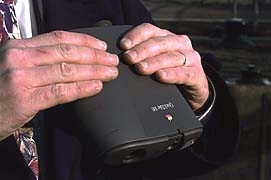
The QuickTake 100 has a binocular style shake-free grip similar to the Canon Ion. It is attractively styled and finished in matt grey.

"Venus is said to be a simple camera
with a 640 x 480 pixel resolution - the same as a screenful of VGA - which
stores twenty five pictures in solid state memory. Cost may be as low as
£700. Rumours that the camera is being developed in association with
Kodak and Chinon are said to have been met with a 'no comment' response
from Kodak When I have any firm news, you'll be the second to know."
That was Chip Shop as long ago as October 1993. Except for the price, we
were very close. When I met the boss of Apple's Advanced Technology Group
at Apple's Cupertino headquarters, in California, at the end October 1993,
he would say little more - except that the camera was not intended to replace
film. Oh, really?
The camera was launched at the Tokyo MacWorld Expo on 17 February 1994 and
will be available in May 1994, to work with Apple Macintosh computers, at
an expected street price of £535. A Windows version will be available
from June 1994 at £599. The one camera does both; only the interface
is different.
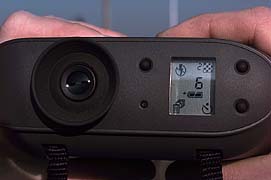
The QuickTake 100 runs off three AA-size batteries and weighs only one
pound. It is very easy to use and - a major breakthrough - does not require
complicated and often idiosyncratic SCSI connection to the host computer.
Communication between camera and computer is via a simple serial cable,
which plugs into the modem or printer port at one end and the camera at
the other.
Apple see the camera being used for business, education and "memories".
It is fully automatic, with a built-in flash. A window at the rear of the
camera is surrounded by four buttons which control the flash, picture resolution,
self-timer, and delete functions. The camera can store up to 32 images at
a resolution of 320 x 240 pixels - each a quarter of a 13 inch monitor screenful
- or eight 640 x 480 pixel images - each a full 13 inch monitor screenful
- for up to a year in its internal flash memory. The resolution can be changed
on a shot-by-shot basis if required.

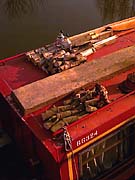
An internal processor automatically adjusts the camera's exposure time
to obtain correct exposure. The lens has a focus range of 4 feet to infinity,
with an equivalent focal length to a 50mm lens on a 35mm camera. The camera
uses a new file format, QuickTake, which uses QuickTime to decompress images.
Images may be saved in TIFF, PICT and JPEG- compressed PICT formats.
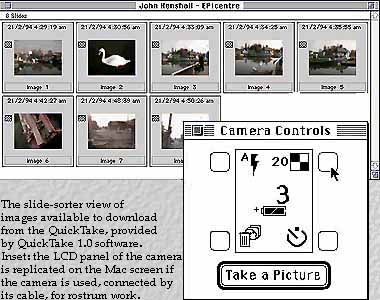
It will be interesting to see what uses the camera is put to. We could
see an immediate use for grabbing shots of artwork for positional indication
in books and magazines, so I mounted it on a Kaiser copy stand, kindly loaned
by KJP, and held a 5 dioptre close-up lens in front of the camera. The results
were perfectly good enough for that purpose and it would be useful if Apple
supplied a close-up attachment, including a frame, since viewfinder parallax
at close distances is large.
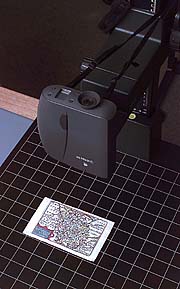

Using "Get Info" on the Macintosh reveals the copyright statement,
showing that the copyright is jointly held by Apple Computer Inc and Eastman
Kodak (Japan). The camera comes with simple to use software which enables
the stored images to be downloaded to the computer. Once in the computer,
the images rotated, sized, cropped and saved in a variety of formats and
colour bit depths.

The Apple QuickTake 100 is a simple but well designed 'sexy' product
which is easy and fun to use. If it catches on, it will be the forerunner
of a line of products which could change the way families take, manage and
print their social pictures.